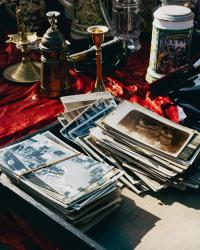Subscribe to the Newsletter
Your cart is empty
Shop now























Coming of “Namaste or Whatever”
Recently, I visited “The Culture” exhibition at the Schirn Museum in Frankfurt, produced in collaboration with the Baltimore Museum of Art to celebrate Hip-Hop’s 50th anniversary. The exhibition showcased works influenced by Hip-Hop culture, predominantly created by people of colour and other minorities for whom it is a way of life. Interestingly, it wasn’t the artwork that caught my attention, but the audience. Despite waiting 30 minutes to enter the exhibition space as it had reached full capacity. In a sea full of people, I only saw one other person of colour. It was all white bodies in this white cube space, reminiscent of the gallery scene from “La Haine.” This experience led me to question: who do we make art for? Is it just fodder to explain to the Other, or is it really for our community? If it’s for our community, how do we present it to them?
I did a commission for an artisanal fashion brand based in New Delhi. The designers’ philosophy is to bring forgotten Indian crafts back to the global landscape, by using a “Western” silhouette with “Indian” elements. The core tenet of the brand is to reintroduce humanness into clothing. Each item of clothing has some handmade element such as specific block printing techniques or certain embroideries and each season the brand visits a subculture from India's heritage. However, despite this, the designer realised that they weren’t doing so well in India. Maybe because we already experience it, we do not need to be reminded of it, of our experience. Their biggest market is New York City and London, even though their only flagship store so far is in New Delhi. To become global they had begun to sell India to the West. I feel like I do the same, continuing to appease the West.
The question of the audience has deeply interested me in recent years. Despite getting a few opportunities across Europe, I have not been able to show my work in India thus far. For me, the question relates to how historically the West has perceived India and vice versa. Photography was introduced to India in the mid-1850s by the British. To them, it was an ideal instrument for chronicling their journey to places old and new, to catalogue ethnicities, communities, cultures, flora, and fauna. I question what I do differently. I too visit places old and new and interrogate them through my camera lens. Through research, I realised that the term “Indian Photography” referred to photography of India most often by outsiders, framing a fraught dialogue between the country and the rest of the world.
With Namaste or Whatever, an ongoing project, I aim to investigate the relationship between India and the West using the history of photography as a point of reference, focusing on how photography has been used as a medium to further appropriate our culture and further perpetuate certain cliches. About how the British gaze blissfully ignored the spirit, the reality of the force that things contain - they are isolated from the web of meanings they are embedded in, robbed of their depth. To paraphrase and interpret an excerpt from James Baldwin’s book ‘Nobody Knows My Name’: Art is about appropriation. In the West, art is rarely created out of necessity; it is often done for art’s sake. When I say art is about appropriation, I mean it involves taking elements out of their environment or natural habitat and placing them into a white cube space. Often, this happens in a foreign context, sometimes intending to educate the “Other.” While this may not always be the artist’s intention, art inevitably reaches certain spaces it was never meant to.
Whilst working on This Isn’t Divide and Conquer, the political climate of India was deeply present in my mind. With the recent re-election of India’s right-wing government led by the right wing government of India, there has been a resurgence of divisive, polarising tactics reminiscent of the British “Divide and Conquer” strategy. This tactic historically led to one of the largest forced migrations and countless deaths during the Partition, and it continues to foster deep-rooted animosity between India and Pakistan. In contemporary India, these tactics are being employed again to polarise communities along religious lines, threatening to overshadow our shared histories and similarities. My project aims to highlight these commonalities, to serve as a point of dialogue in a time of political division. By focusing on the India-Pakistan border as a symbol of separation and a repository of shared history, I hope to encourage a re-examination of how we understand and relate to each other across these divides. Yet I have not been able to show it to “my” people. Always the “Other,” in a land where I am the Other. Who do I make work for?
Aaryan Sinha is part of »Guest Room: Damarice Amao & Matthias Pfaller«.